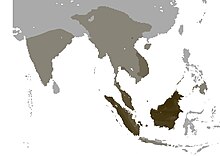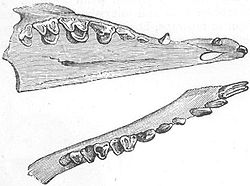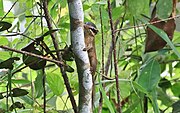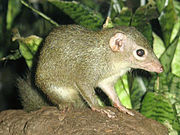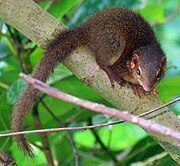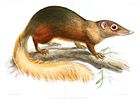
Placental mammals are one of the three extant subdivisions of the class Mammalia, the other two being Monotremata and Marsupialia. Placentalia contains the vast majority of extant mammals, which are partly distinguished from monotremes and marsupials in that the fetus is carried in the uterus of its mother to a relatively late stage of development. The name is something of a misnomer considering that marsupials also nourish their fetuses via a placenta, though for a relatively briefer period, giving birth to less developed young which are then nurtured for a period inside the mother's pouch. Placentalia represents the only living group within Eutheria, which contains all mammals more closely related to placentals than to marsupials.

Colugos are arboreal gliding mammals that are native to Southeast Asia. Their closest evolutionary relatives are primates. There are just two living species of colugos: the Sunda flying lemur and the Philippine flying lemur. These two species make up the entire family Cynocephalidae and order Dermoptera.

Euarchontoglires, synonymous with Supraprimates, is a clade and a superorder of mammals, the living members of which belong to one of the five following groups: rodents, lagomorphs, treeshrews, primates, and colugos.
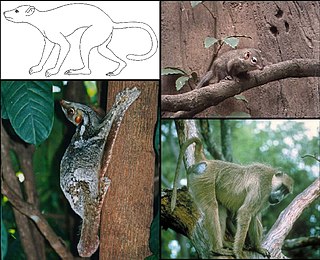
The Euarchonta are a proposed grandorder of mammals: the order Scandentia (treeshrews), and its sister Primatomorpha mirorder, containing the Dermoptera or colugos and the primates.

Glires is a clade consisting of rodents and lagomorphs. The hypothesis that these form a monophyletic group has been long debated based on morphological evidence. Two morphological studies, published in 2001 and 2003, strongly support the monophyly of Glires. In particular, the 2003 study reported the discovery of fossil material of basal members of Glires, particularly the genera Mimotona, Gomphos, Heomys, Matutinia, Rhombomylus, and Sinomylus. Their description, in 2005, helped to bridge the gap between more typical rodents and lagomorphs. Data published in 2001, based on nuclear DNA, supported Glires as a sister of Euarchonta to form Euarchontoglires, but some genetic data from both nuclear and mitochondrial DNA have been less supportive. A study, published in 2007, investigating retrotransposon presence/absence data unambiguously supports the Glires hypothesis. Studies published in 2011 and 2015 place Scandentia as a sister clade of the Glires, invalidating Euarchonta as a clade.

Mammalia is a class of animal within the phylum Chordata. Mammal classification has been through several iterations since Carl Linnaeus initially defined the class. No classification system is universally accepted; McKenna & Bell (1997) and Wilson & Reader (2005) provide useful recent compendiums. Many earlier ideas from Linnaeus et al. have been completely abandoned by modern taxonomists, among these are the idea that bats are related to birds or that humans represent a group outside of other living things. Competing ideas about the relationships of mammal orders do persist and are currently in development. Most significantly in recent years, cladistic thinking has led to an effort to ensure that all taxonomic designations represent monophyletic groups. The field has also seen a recent surge in interest and modification due to the results of molecular phylogenetics.
The Archonta are a now-abandoned group of mammals, considered a superorder in some classifications, which consists of these orders:

The Madras treeshrew, also known as the Indian treeshrew, is a species of treeshrew in the monotypic genus Anathana found in the hill forests of central and southern India. The genus name is derived from the Tamil name of moongil anathaan and the species name is after Sir Walter Elliot of the Indian Civil Services in Madras.
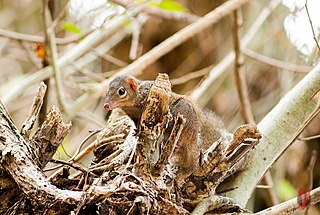
The northern treeshrew is a treeshrew species native to Southeast Asia.

The northern smooth-tailed treeshrew is a species of treeshrew in the family Tupaiidae found in Cambodia, Thailand, and Vietnam. Their diet primarily consists of invertebrates but rarely includes fruits and plants.

The pen-tailed treeshrew is a treeshrew of the family Ptilocercidae native to southern Thailand, the Malay Peninsula, Borneo, and some Indonesian islands.
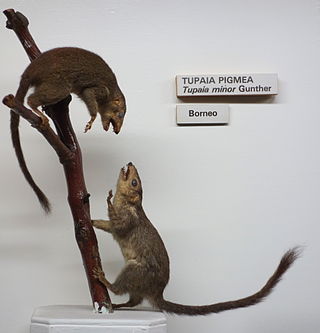
The pygmy treeshrew is a treeshrew species within the family Tupaiidae. It is native to Thailand, Malaysia and Indonesia. The generic name is derived from the Malay word tupai meaning squirrel or small animals that resemble squirrels.

The large treeshrew is a treeshrew species within the Tupaiidae. It is native to Sumatra and adjacent small islands, as well as in the lowlands and hills of Borneo.

The Mindanao treeshrew, also called the Philippine tree shrew, is a species of treeshrew endemic to the Mindanao region in the Philippines. It was formerly considered the only member of the genus Urogale, but that genus was merged into Tupaia when the species was found to nest within the latter genus in a molecular phylogeny. The scientific name commemorates British colonial administrator and zoological collector Alfred Hart Everett.

Tupaia is a treeshrew genus in the family Tupaiidae that was first described by Thomas Stamford Raffles in 1821. The name of this genus derives from the Malay word tupai meaning squirrel or small animal resembling a squirrel.

Tupaiidae is one of two families of treeshrews, the other family being Ptilocercidae. The family contains three living genera and 19 living species. The family name derives from tupai, the Malay word for treeshrew and also for squirrel which tupaiids superficially resemble. The former genus Urogale was disbanded in 2011 when the Mindanao treeshrew was moved to Tupaia based on a molecular phylogeny.

Primatomorpha is a proposed mirorder of mammals containing the orders Dermoptera and Primates. Primatomorpha is sister to Scandentia, together forming the Euarchonta.
Tupaia miocenica is a fossil treeshrew from the Miocene of Thailand. Known only from a single tooth, an upper first or second molar, it is among the few known fossil treeshrews. With a length of 3.57 mm, the tooth is large for a treeshrew. At the back lingual corner, the tooth shows a small cusp, the hypocone, that is separated from the protocone in front of it by a narrow valley. The condition of the hypocone distinguishes this species from various other treeshrews. In addition, the presence of a well-developed but simple mesostyle is distinctive.


